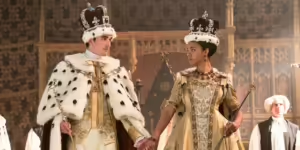
Our favorite messy love story is about to become a whole lot more real.
Quoting Lady Whistledown from the opening scenes of the Netflix series, Queen Charlotte: A Bridgerton Story, the series is “fiction inspired by fact.” This Bridgerton spinoff follows the pasts of three powerful women from the original show with our outlandish wig-wearing Queen Charlotte (Golda Rosheuvel) in the forefront. Inspired by two very real figures from history, the show takes heavy creative freedom with Queen Charlotte’s and King George III’s love story, but there are many key points that are actually true. With a talented cast and stunning Regency period gowns and architecture, this re-imagining of the royal couple’s love story is messy and complicated but beautiful nonetheless.
Was King George III Mad?
As depicted in Queen Charlotte, King George III (Corey Mylchreest) was actually popularly known as “Farmer George,” due to his keen interest in agriculture, and “Mad King George,” due to his mental health condition (via The Royal Family) . Although there is still debate about the origins and nature of what was reductively termed his “madness,” its presence is undeniable since he was forced to hand over the reins of his throne to his son, the Prince Regent, once he reached middle age. Reports indicate that he experienced convulsions, ramblings, frothing at the mouth, and episodes of depression, which later progressed to vision, auditory, memory, and mobility losses. The prevailing theory about the cause of the king’s symptoms is porphyria, a hereditary physical disease that attacks the nervous system, but more recently, scientists and medical researchers have suggested he actually had chronic manic episodes associated with bipolar disorder and dementia in his later years. The show decided to run with the latter theory, introducing Dr John Monro (Guy Henry), who reduced George was “merely suffering a disorganization of the nerves,” euphemistically alluding to the treasonous claim of “insanity” at the time.

Like in the show, King George was confined to and treated at a home in Kew (via History). However, in real life, he was forced to go instead of willingly accepting the treatments. His royal physician was Dr. Francis Willis, the leading mental health expert at the time, who suffered the king to horrific treatments that were misguided by contemporary beliefs and based on extreme restriction, as Dr Monro explained. On screen, we see limited portrayals of the actual treatments, with Mylchreest contorting his face to mimic what could only be a fraction of the pain King George had to endure. But the shots of the closed doors and deafening screams work; it’s more terrifying to let your imagination fill in the gaps. In real life, the various inhumane treatments the king was reported to have included straitjackets, arsenic powder skin treatment, fasting and purging, ice-cold baths, isolation, and confinement (via History). And unlike the on-screen King George, he had to endure the treatments for the rest of his life until his death in 1820.
Was Queen Charlotte Black?
Portrayed as the first Black queen of England, Queen Charlotte (India Amarteifio) has to navigate the racial implications of her ascendance and the social change that is incited because of it. The figure she was inspired from, Queen Sophia Charlotte of Mecklenburg-Strelitz, was at the center of decades of debates on her racial identity. Since all portraits are illustrated with pale skin and her ancestry is traced back to German lineages, it was widely accepted that she was white until the 1940s. J.A. Rogers proposed in his book Sex and Race: Volume 1 that her “broad nostrils and heavy lips” indicated she was of Black or biracial descent. Later, a historian even identified a branch of her ancestry that was from a Black Portuguese royal family, Margarita de Castro e Sousa. However, academic Ania Loomba suggests there was an error in translation (in an interview with Inquirer), claiming that “moor” does not inherently mean Black but can also refer to “white from North Africa.” Her racial identity is still a controversial topic, but it is clear that the Netflix show decided that Queen Charlotte should be Black in the world of Bridgerton.
Did the “Great Experiment” Exist?
One of the significant plot lines in Queen Charlotte was the radical “great experiment,” where the monarchy catalyzed the desegregation of the Black and white communities of the ton. When George’s mother (Michelle Fairley) arranged the marriage between him and Charlotte, she expressed bias against Charlotte’s skin color, but with George’s conditions and the time constraints on producing an heir, she reluctantly pronounced it to be “the great experiment.”
